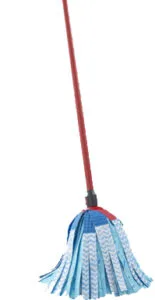There are three basic types of mop: sponge mops, twist mops, and microfiber mops. Read below to know which one you need for your home.

The Twist Mop
leaves very little water on the floor and is is a good ergonomic choice, using a figure eight arm motion to mop without straining the back. The mop-head works around tight spaces and tough angles. A great mop for the whole house including wood floors.
Avoid rope yacht mops. They are deceptively light, expanding in size and weight when wet, so even a light, small rope mop swells to a monster size. The result is a heavy, unwieldy mop that is hard to wring.

The Microfiber Mop
The cleanest, greenest mop-head is the microfiber. The mop-head can be laundered and reused endlessly. Other mop-heads suffer a mere rinse and wring before going whole hog on the floors again and again. The swivel head can be used in either the figure eight or a sweeping motion. The flat head allows the mop-head to slip under low furniture and the edges of appliances like your fridge and stove.
With more than one cloth mop-head, you can dry-dust, damp-dust, and full mop different areas of your home.
One draw back is the hand-wringing required for full mopping. Self-wringing buckets do not provide as much control as hand-wringing.
The microfiber mop doubles as a dust-mop for floors and for walls. It makes a great wall washer, covering ground in record time. Spray water or floor spray on floors and the mop-head picks up dirt and leaves a shine. Perfect for wood floors and areas that don’t require a full mop.

The Sponge Mop
The sponge mop is good for small areas without much clutter or detail – generally the kitchen.
Sponge wets the floor more, which can be desirable in kitchens with lots of action. However, too much water is an issue for wood floors.
The sponge is an option for you if who don’t have any wood floors or you want a separate mop dedicated to the kitchen alone.
The sponge mop requires a sweeping motion, making it a poor choice ergonomically for large areas. Mopping a whole house with sponge is not recommended.
In the event you are stuck with sponge, here’s how to protect your back: keep the mop close to your body and work on small floor sections at a time. We call this “dancing with the mop”. Take care not to overreach and extend the back when mopping. Don’t let your partner go too far and you will avoid back fatigue – a nagging lower back ache at the end of the day.

Stick to Basics
Quick Guide to Mops
1. The most eco-friendly = microfiber mop.
2. The most ergonomic = twist mop
3. Fastest to dry = twist mop
4. Least water = spray & dust-mop with microfiber mop
5. Doubles as a dust-mop = microfiber mop
